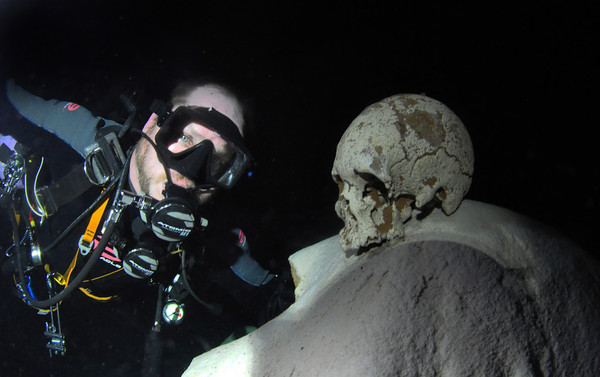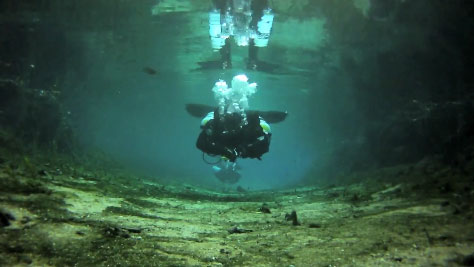Profound Cave Dives of 201030 December 2010 For me, this year has held many trials and tribulations. It was a great year for learning, sharing, reconnecting and reflection. I will always look back at this year as a year that defined me. 2010 was a year of substantial losses and gains that I never thought unimaginable; the birth of a son and the loss of my best friend. As I look back at my cave diving and exploration this year, I can think of a few cave dives I was involved with in 2010 that I reflect fondly upon and have made a profound impact on me.
Undisclosed Cenote, Yucatan, Mexico  As I dropped 130’ into a room over 300’ in diameter and 100’ tall, I was awe struck! Such an amazing and foreboding place; this cave ate light like no other cave I have experienced. As I slowly rappelled into the abyss, my eyes strained to make out the distant walls of a cavern that the local inhabitants had no idea just how expansive it really was. As I dropped 130’ into a room over 300’ in diameter and 100’ tall, I was awe struck! Such an amazing and foreboding place; this cave ate light like no other cave I have experienced. As I slowly rappelled into the abyss, my eyes strained to make out the distant walls of a cavern that the local inhabitants had no idea just how expansive it really was. In so many of the caves we explore, we are often times the first to discover them as well. However, the seven skulls we found in this cave reminded me that I was not the first. It was difficult to imagine how they came to call this cave their final resting place – so many options. Were they slaves simply tossed into the cavernous depths as mere chattel, were they sacrificed by the Maya eager to appease the gods of rain, or simply victims of being the town drunk taking the wrong step at the wrong time. I hold all of them in reverence and have been honored to share their amazing find. La Jeringa, Bayahibe, Dominican Republic Here we discovered and recovered the most intact New World primate ever found – Antillothrix Bernisis. The journey of finding this primate and recovering it has been filled with new friends and challenging situations. I will be forever indebted to Dr. Alfie Rosenberger for his drive, desire and willingness to teach me. He has made me a better and more thoughtful explorer. I am proud we made the right choice to find the right person to handle these primate fossils. My thought is that this expedition, these cave dives, this project, will open up the world of underwater primate paleontology and create a unique cohesion between cave divers and the world of academia. Using UV lighting underwater to fluoresce bones and teeth was a known first in underwater archeology. It is so rewarding to know that I was there and the world has more knowledge because of it! Eagle’s Nest, Hernando County, Florida This dive, serving as the beginning of my much needed catharsis, taught me volumes about preparation, training, gear and just how much a dive partner affects the dive (both positively and negatively). I wrote a pretty substantial article about this (The Cathartic Cave Diver) and won’t dwell much on it here. Read it, I hope it helps you understand the mindset of the “solo cave diver” better. Manatee Spring, Levy County, Florida I was once told that if I survive my life on this Earth with more friends than I can count on one hand I would be a very blessed man. I know I am blessed: blessed with astonishing friends, a loving family, a career and endless opportunity. I give thanks for this daily but not nearly as much as I should. However, in the darkest of my days my dear friends decided we should just go piddle around in Manatee as a good last cave dive to the year that will some become the past. It wasn’t the dive that was most impactful, it was simply the caring side of friends that put others well ahead of themselves. But, any cave dive is better than a day not exploring our amazing planet! A nice swim from Catfish to Friedman’s will do any soul good – and burn a few calories. I hope everyone has had as great a year as I did exploring this beautiful blue marble we call Earth. I am currently gearing up for a return trip to the Yucatan jungle next month and several more exciting cave diving expeditions we have planned for 2011. As always, if you think of something I can do to make Cave Atlas better, please let me know! The Mastery of Cave Diving22 December 2010  Curt and I spent last weekend diving with Josh Bernstein and sharing with him our views on sidemount cave diving and giving him some tips on technique. As much as I was excited to do so, I will still nervous – I am not an instructor, nor do I aspire to be one. Our "group" has always focused on mentoring and passing on lessons learned, gear configuration ideas and pretty much anything that would make each other better divers and explorers, but these dives were a little different. Albeit, Josh is an accomplished explorer in his own right, he is still new to sidemount cave diving and above all, a newcomer to our "group" – a very welcomed newcomer. Curt and I spent last weekend diving with Josh Bernstein and sharing with him our views on sidemount cave diving and giving him some tips on technique. As much as I was excited to do so, I will still nervous – I am not an instructor, nor do I aspire to be one. Our "group" has always focused on mentoring and passing on lessons learned, gear configuration ideas and pretty much anything that would make each other better divers and explorers, but these dives were a little different. Albeit, Josh is an accomplished explorer in his own right, he is still new to sidemount cave diving and above all, a newcomer to our "group" – a very welcomed newcomer.I have spent the past few months getting to know Josh and trying to convince him to do some cave exploration with us in the Dominican Republic, unfortunately our schedules never meshed. However, he will be joining us on our trip to Mexico as an explorer – he will be on rope and in the caves. That pretty much set up the reason for him to come to Florida and learn sidemount cave diving. Our group rarely dives anything other than sidemount on expedition as the terrain logistically doesn't support humping doubles through the jungle (nor do most of the caves we discover). We thought we would get Josh settled into his newly fit Armadillo Sidemount Exploration Harness and introduce him to Florida caves by visiting Ginnie Springs. Nothing like a little flow to contrast the still water of most Mexican caves! Josh's buoyancy and trim were spot on. Although the Armadillo rig is built to provide this, usually new sidemount divers take a little while to dial it in. The tasks that now lie ahead for Josh are hose routing, experience and comfort. The mastery of this is critical to being a successful sidemount cave diver. Working with Josh and watching Doug Mudry teach a GUE Fundamentals class, made me think about what it is we do and why it is that we do it. For some, cave diving is a recreational sport, for others it is a way of life (I am part of the latter group). Doug's students looked amazing in the water: trim, buoyancy, etc. That is the hallmark of GUE training – they look good in the water. These are critical initial skills any cave diver must learn, but new skills must be added as the caves dictate. Hence, Josh expanding his skills by adding sidemount cave diving. Many times we are in cave systems that don't allow you to look good in the water. The byproduct of digging and scraping is seeing caves that very few people ever have or no one ever has! I think one of my personal mottoes sums this up nicely – "If you don't go, you won't know". In my opinion, you must be able to master many skills and several types of diving in order to be ready to explore anything. Our group is comprised of like-minded and like-skilled explorers. We all cave, cave dive and climb, we also all backmount, sidemout, nomount and use rebreathers. In addition, we are always in pursuit of mastering each of these skills as you never know what type of equipment a newly discovered cave is going to dictate to you. Josh and I talked about mastery a few times. The last time we discussed mastery was walking back from Jug Hole and talked about how impressed I was by his dogged approach at a particular sidemount skill known as "supermanning". Supermanning is swimming while holding both tanks in front of you while the neck of the tank is still attached. A critical skill that is important for passing very small cave restrictions. Josh told me he wanted to master that skill as he does all skills, but this one in particular. He will tell you he is working on it; I will tell you he's mastered it. Mastery of your skills is a must, but you also must learn self-mastery. Cave diving and most importantly exploring and discovering new caves, can sometimes present threatening or challenging situations. Because of this, you must master your emotions and how your body reacts to these situations, just as you have mastered your skills. There are 5 basic rules of cave diving that were developed as a result of accident analysis and presented in Sheck Exley's Blueprint for Survival but I believe there is a 6th unwritten rule – "You panic, you die!". When you find yourself in a threatening or challenging situation never let your adrenaline takeover, remain calm and most importantly think! Fallback on the skills you have already mastered: your training, your skills and your gear. Many people will say they are afraid of dying, I am afraid of not living! Whatever your passion, don't just be good at it – MASTER IT! |
Recent Posts
Archives
|
